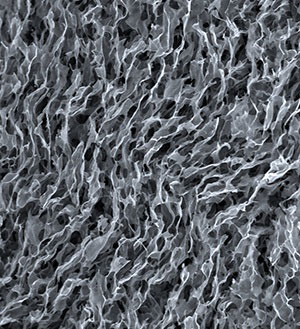| Jul 19, 2011 |
Graphene oxide: a new order
|
|
(Nanowerk News) Considerable research has been devoted to the use of graphene in electronic devices, but researchers are also paying attention to the possibility of creating functional materials from liquid suspensions of chemically derived and chemically modified graphene. A suspension of chemically oxidized graphene, for example, can be easily obtained by oxidizing graphite and dispersing it in a solvent, and such suspensions can be used to produce durable graphene paper or porous graphene oxide films suitable for application in supercapacitors and batteries.
|
|
Intrigued by the possibilities offered by the use of graphene oxide suspensions, Zhen Xu and Chao Gao from Zhejiang University in China have now demonstrated that suspended graphene oxide can adopt a liquid crystal-like phase ("Aqueous Liquid Crystals of Graphene Oxide"). Their finding could lead to the development of materials consisting of long-range-ordered assemblies of graphene oxide sheets.
|
 |
| A scanning electron microscopy image of a nematic-phase graphene oxide foam freeze-dried from its liquid-crystalline suspension.
|
|
Using polarized optical microscopy, the researchers found that graphene oxide solutions with a sufficiently high volume fraction of graphene oxide exhibited birefringence — a commonly accepted signature of an isotropic-to-nematic phase transition in a liquid crystal. By extending the study as a function of both volume fraction and salt concentration, they were able to construct a full phase diagram that revealed in addition to the nematic and isotropic phases also a mixed phase and a flocculated solid phase at very high salt concentration.
|
|
Xu and Gao then observed these phases directly by scanning electron microscopy after freeze-drying foams of the graphene oxide solutions (see image). These observations showed that the isotropic phase consisted of irregular clusters of graphene oxide, whereas the nematic phase was comprised of graphene oxide sheets in an ordered alignment.
|
|
According to the researchers, the discovery of liquid crystal-like phases of graphene oxide in solution could lead to some promising applications. "Liquid-crystalline graphene oxide would make it possible to produce macroscopic structures of aligned graphene sheets, which could be used in strong fibers, functional textiles, field-emission displays and even energy storage," says Gao. The discovery is also interesting from a fundamental research perspective in that graphene oxide can now be explored as a model system for liquid crystal theory and simulations with potential for new insights in colloidal fluid physics.
|

